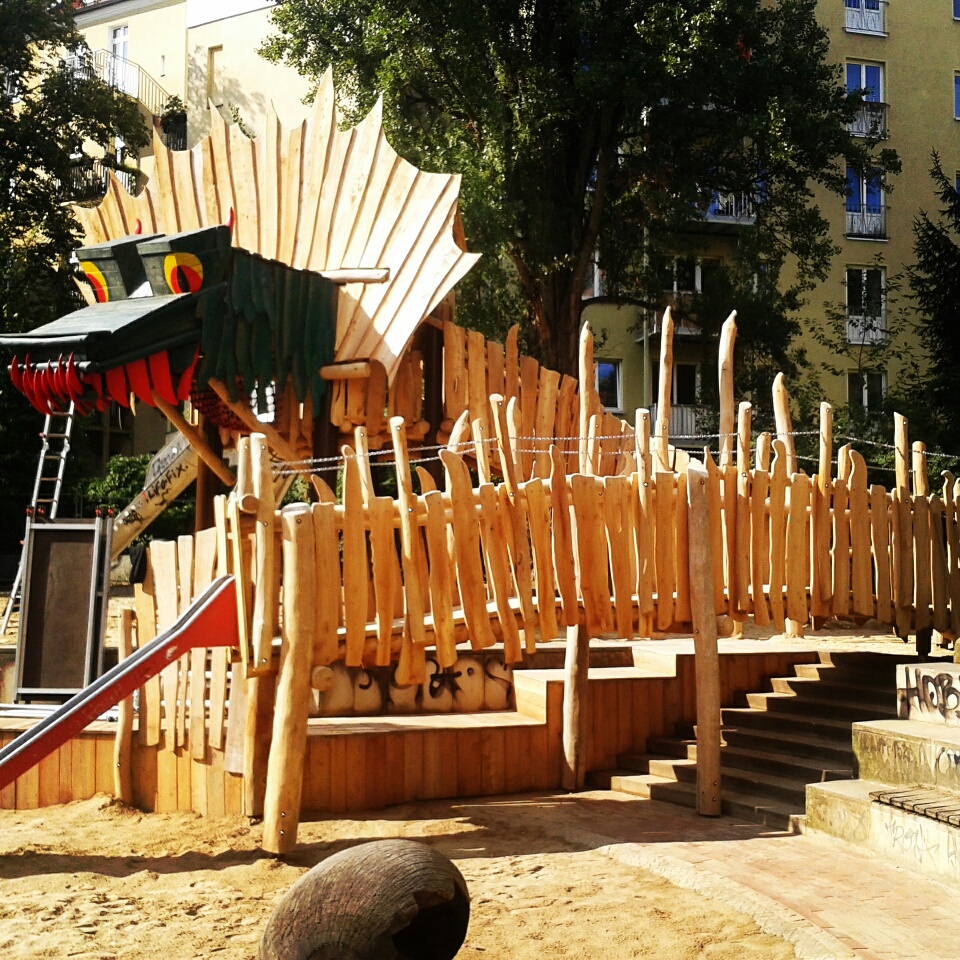When I moved from the U.S. to Berlin nearly two years ago, many of the differences were clear to me upon arrival. The quintessential European sidewalk cafes, a sprawling mass transit system, well-tread bike lanes, and language barriers that reminded me that, no, I was not in Kansas anymore. But only after wandering some of the quieter streets did I pick up on another phenomenon I had never encountered in the states: the elaborate and adventurous playgrounds located in parks and nestled in public reserves throughout the city.
In Berlin, there are over 2,000 designated “play areas.” To me, a foreign observer, many of the structures appear almost slipshod, tethered to recycled materials and lacking railings at heights that would be extreme in the U.S. Outside of my office window there is a playground that looks like a tree house out of The Jungle Book or Swiss Family Robinson—there are no guardrails on the upper decks, and the bowed metal and wood create an ship-like design. Many of the playgrounds seem like open decks, hidden cubbyholes and platforms, for children to create their own imaginary meaning of the space.
In other play areas, children can be seen frolicking—sometimes naked—at dangerous heights (the nudity isn’t shocking after you have been to one of the many nude beaches in Germany). In Mitte, children can be seen jumping from platforms onto thick mats or crawling through constructions that more resemble a secret childhood fort than a public playground or schoolyard. Some of the playgrounds were actually built by children themselves.
Perhaps this is what childhood should look like.
According to Joe L. Frost, a leading expert on play and playgrounds, in the American Journal of Play, “Thousands of playgrounds throughout Europe, but especially in England, Germany, and the Scandinavian countries are more challenging, more fun, and more developmentally beneficial than most in this country, but most Americans see them as messy and hazardous. Europeans place more responsibility on children for their own safety.” He also adds that standard-compliant equipment in the United States “increased as lawsuits mushroomed due to expanding opportunities to win financial settlements and judgments over playground injuries.”
It is widely known that premises liability lawsuits are far less common in Germany and other European countries. At least one of the reasons for this disparity is that damages are capped and usually only cover immediate losses, such as medical bills or lost wages. In the U.S., a major incentive to litigate is the potential for excessive punitive damages and jury verdicts, which are non-existent in Germany. Lawyers are also not allowed to take cases on contingency, meaning that victims must pay for the costs and can potentially be liable for additional court costs if unsuccessful.
As a lawyer, I have always been urged to hold individuals and entities accountable, especially when it comes to children. Still, Berlin playgrounds offer a counterpoint, illustrating what we have potentially lost through fear and litigation. Children’s playgrounds are far more sophisticated and elaborate in Berlin, a quality that is both aesthetically and developmentally compelling. The structures recall a freer and less risk-averse society and give children an open-minded space to explore, create, and imagine. Is our desire to find blame and ensure accountability stripping away certain freedoms and potential, even a quality of life?
The playgrounds seem a metaphor of a kind of lifestyle that extends beyond “play”—there is a recognizable autonomy and responsibility that is both grounding and refreshing. As Irene Hagstrom, a mother of three explained, “It’s my responsibility to choose which playgrounds are suitable for my kids based on their age and capability. When they were smaller I chose not to visit some that I thought were two dangerous.” She added, “Having lived in Australia where the playgrounds are much less adventurous, also due to the ‘suing factor,’ I was pleasantly surprised here by the challenging playgrounds.”
As a foreigner, the more I absorb it all, the more the benefits of these “dangerous playgrounds” seem to outweigh additional risks of injury. (But indeed, German insurers have actually cited more injuries on playgrounds intended to be “safe” than on playgrounds where parents are not hovering and children are encouraged to be creative. One playground I visited even had hours that barred adults from entry.)
Though a few families may become beneficiaries from high-stakes litigation in the U.S., the question that remains for me is, what is the system costing our children? The infrastructure in the world around us is often based on forces we cannot see—regulations, standards, compliance issues that escape us as everyday participants. U.S. parents may not recognize the the loss of exploration and creativity that exist only to insulate schools, governments, and other private entities from litigation.
Kate Leismer is a freelance writer and lawyer based in Berlin, Germany. Read more of her work at www.kateleismer.com.















